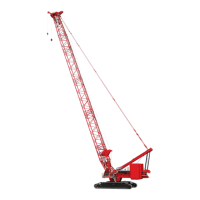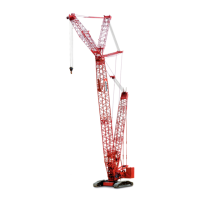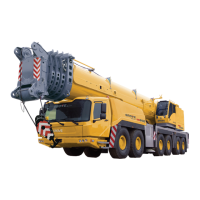Manitowoc Published 11-22-17, Control # 257-02 10-19
MLC300 SERVICE/MAINTENANCE MANUAL ACCESSORIES
10
RIGGING WINCH (DRUM 0)
General
This part of Section 10 provides operational information and
electrical and hydraulic schematics for the rigging winch
system.
Additional component information for this system can be
found in the following sections of the Service Manual:
• Section 2: Hydraulics
• Section 3: Electrical
The rigging winch is controlled by the setup remote.
Setup Remote Control
The setup remote control communicates with the CCM-10
control module via the controller area network bus (CAN
Bus). The crane control modules use the CAN Bus to
communicate with each other.
To operate the setup remote, it must be turned on as
instructed in the MLC300 Operator Manual.
See Figure 10-14
and Figure 10-15 for the following
descriptions.
Neutral
When there is no command from the setup remote:
• Pump 3 hydraulic flow through system B (right valve
assembly) decreases.
• The isolation valve B shifts to neutral to block pump flow
to the rigging winch valve.
• The rigging winch valve shifts to neutral to block pump
flow to the rigging winch.
• The holding valve closes to prevent the winch from
paying out. The shuttle valve provides a return flow path
from the brake to tank, so the brake spring applies.
Haul In
When a haul in command is initiated by the setup remote, the
setup remote receiver communicates the command to the
CCM-10 control module. The CCM-10 control module then
communicates the haul in command to the CCMC11 and
IOLC30 control modules via CAN Bus C.
The following then occurs:
• The CCM-10 control module increases the PWM current
to pump 3 to increase system B (right valve assembly)
hydraulic flow.
• The IOLC30 control module sends 24 V
DC
to the side B
solenoid on isolation valve B. The solenoid energizes
because the CCMC11 control module provides a ground
for the solenoid. The energized solenoid shifts the valve
spool to a position that routes hydraulic fluid to the
rigging winch valve.
• The CCMC11 control module then sends 24 V
DC
to the
corresponding solenoid on the rigging winch valve,
energizing the solenoid. The valve spool shifts to a
position that routes hydraulic fluid to the holding valve.
• At the holding valve, hydraulic fluid flows through the
check valve to the haul-in port on the hydraulic motor.
Hydraulic flow shifts the shuttle valve, and hydraulic
pressure releases the winch brake. The hydraulic motor
turns the drum in the haul-in direction.
• Hydraulic fluid leaving the opposite side of the motor
flows back to tank via the rigging winch control valve.
Pay Out
When a pay out command is initiated by the setup remote,
the setup remote receiver communicates the command to
the CCM-10 control module. The CCM-10 control module
then communicates the pay out command to the CCMC11
and IOLC30 control modules via CAN Bus C.
The following then occurs:
• The CCM-10 control module increases the PWM current
to pump 3 to increase system B (right valve assembly)
hydraulic flow.
• The IOLC30 control module sends 24 V
DC
to the side B
solenoid on isolation valve B. The solenoid energizes
because the CCMC11 control module provides a ground
for the solenoid. The energized solenoid shifts the valve
spool to a position that routes hydraulic fluid to the
rigging winch valve.
• The CCMC11 control module then sends 24 V
DC
to the
corresponding solenoid on the rigging winch valve,
energizing the solenoid. The valve shifts to a position
that routes hydraulic fluid to the pay-out port on the
hydraulic motor.
• At the same time, hydraulic flow shifts the shuttle valve
and hydraulic pressure releases the winch brake.
• Pilot pressure from the pay-out side of the hydraulic
motor shifts the holding valve open, allowing the motor
to turn in the pay-out direction.
• Hydraulic fluid leaving the opposite side of the motor
flows through the open holding valve and back to the
tank via the rigging winch control valve.
Load Holding
If system pressure is lost, the winch brake spring applies and
the holding valve closes to stop the winch and prevent it from
paying out.

